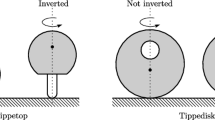Abstract
This work aims to investigate the Rayleigh Disk, a simple device used for measuring the intensity of acoustic fields. A Rayleigh Disk refers to a small disk suspended from a light thread that is placed in an acoustic field, which will tend to align itself to the incoming wavefronts. We considered two theoretical models to model the dynamics of the Rayleigh Disk, a numerical and an analytic model. We also studied the effect of varying various parameters, such as the radius and initial angle of the disk as well as the torsional constant of the string. We show that the models are accurate for all these parameters by comparing the model predictions with experimental data. We investigated the accuracy of the Rayleigh Disk by using the final angle as a means of predicting the intensity of the sound played. The impact of parameters on the accuracy is also modelled and experimentally verified using statistical methods, such as the \(R^2\) score. We found that the Rayleigh Disk is accurate for a large range of intensities, even when parameters are not optimal. The findings presented in this work help us to gain a deeper understanding of how the Rayleigh Disk functions and its accuracy as a practical tool.
Access this chapter
Tax calculation will be finalised at checkout
Purchases are for personal use only
Similar content being viewed by others
References
Akbarzade, M., Oberst, S., Sepehrirahnama, S., Chiang, Y. K., Halkon, B., Melnikov, A., Powell, D.: A numerical study of acoustic radiation forces for the contactless excitation of a microcantilever, pp. 335–345 (2022)
Jarvis, D.: Sound measurements. Metrologia 36(4), 249 (1999)
Jia, S., Sato, Y., Tsujino, S.: Size and shape dependent rotation characteristics of thin film ultrasonic rotors. Appl. Phys. Lett. 121(25), 254102 (2022)
King, L.V.: On the theory of the inertia and diffraction corrections for the Rayleigh disc. Proc. R. Soc. Lond. Ser. A Math. Phys. Sci. 153(878), 17–40 (1935)
Kotani, M.: An acoustical problem relating to the theory of Rayleigh disc.: Proc. Physico-Math. Soc. Japan 3rd Ser. 15(1), 30–57 (1933)
Merrington, A.C., Oatley, C.W., Richardson, O.W.: An investigation of the accuracy of könig’s formula for the rayleigh disk. Proc. R. Soc. Lond. Ser. A. Math. Phys. Sci. 171(947), 505–524 (1939)
West, W.: The accuracy of measurements by Rayleigh disc. Proc. Phys. Soc. Sect. B 62, 437 (2002)
Wood, A.: A correction to the theory of the Rayleigh disc as applied to the measurement of sound-intensity in water. Proc. Phys. Soc. 47, 779 (2002)
Wood, A.B.: A correction to the theory of the Rayleigh disc as applied to the measurement of sound-intensity in water. Proc. Phys. Soc. 47(5), 779–793 (1935)
Author information
Authors and Affiliations
Corresponding author
Editor information
Editors and Affiliations
Appendices
Appendix A
Derivation
The coordinate system is defined as shown in Fig. 14. Since the sound waves can be modelled as inviscid and irrotational flow, we use the potential flow model, representing the velocity field as the gradient of a scalar velocity potential. The velocity potential follows the wave equation:
The incident velocity potential of plane progressive waves can then be modelled as
and for standing waves the incident velocity potential becomes
The potentials on each side of the disk can be written as an infinite sum of the cylindrical Fourier series
The wave equation can be numerically solved to obtain the velocity potential of the air around the disk. However, an analytic solution is desired since it is much easier to use for further analysis. Hence, the large wavelength approximation is made which allows us to neglect higher-order terms.
These equations are solved on the plane of the disk. The air on the surface of the disk moves at the same velocity of the disk giving us the kinematic boundary condition. Outside the disk, the pressure should also be continuous, hence the velocity potentials are the same.
The difference of pressure between both sides of the disk, \(\delta p\), can be obtained, as well as the difference in the squares of the velocity potentials with q in the following form
Finally, the torque is obtained by integrating these values over the surface of the disk.
Appendix B
Characterisation
Before we can compare our theoretical model and experimental data, we have to empirically characterise some parameters of our setup, namely the drag coefficient, torsional coefficient of the string and the sound power produced by our speaker.
We characterise the drag and torsional coefficient by slightly disturbing the suspended disk in the absence of any sound being played. In this case, the disk acts as a simple damped harmonic oscillator and follows the following equation of motion
We can then fit the solution of this equation to the recorded data to obtain the values of k and \(c_d\) (Fig. 15).
To characterise our speaker, we the sound produced as a Bessel beam in the far field, with the pressure given as
where \(\psi \) is the angle from the speaker (equal to 0 if the point is on axis with the speaker), R is the radius of the speaker, d is the distance of the speaker and \(P_0\) is to be determined.
To determine \(P_0\), we measure the pressure amplitude at different points and when the speaker is running on different voltages and fit Eq. 17 to it (Fig. 15).
Rights and permissions
Copyright information
© 2023 The Author(s), under exclusive license to Springer Nature Singapore Pte Ltd.
About this paper
Cite this paper
Jain, K., Jed, L.L.X., Ziming, Q. (2023). Theoretical and Experimental Analysis into the Accuracy of the Rayleigh Disk. In: Lu, J., et al. Proceedings of the 9th IRC Conference on Science, Engineering, and Technology. IRC-SET 2023. Springer, Singapore. https://doi.org/10.1007/978-981-99-8369-8_20
Download citation
DOI: https://doi.org/10.1007/978-981-99-8369-8_20
Published:
Publisher Name: Springer, Singapore
Print ISBN: 978-981-99-8368-1
Online ISBN: 978-981-99-8369-8
eBook Packages: Physics and AstronomyPhysics and Astronomy (R0)






